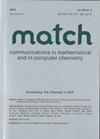AMP-EF:一个用于抗菌肽识别的极端梯度增强和双向长短期记忆网络集成框架
IF 2.4
2区 化学
Q2 CHEMISTRY, MULTIDISCIPLINARY
Match-Communications in Mathematical and in Computer Chemistry
Pub Date : 2023-10-01
DOI:10.46793/match.91-1.109z
引用次数: 0
摘要
近年来,由于抗生素的滥用,细菌耐药性成为一个严重的问题。抗菌肽(AMPs)已迅速成为抗生素的最佳替代品,因为它们能够快速靶向细菌、真菌、病毒和癌细胞,并抵消它们产生的毒素。本研究提出了一个双分支集成框架来识别amp,该框架将极端梯度增强(XGBoost)和双向长短期记忆网络(Bi-LSTM)与注意机制相结合,形成一个更强的模型。首先,采用单热编码和-mer来表示序列特征。然后,将特征向量分别输入到两个基分类器中,得到两个预测值。最后,通过折衷得到预测结果。作为经典的机器学习方法之一,XGBoost具有很强的稳定性,可以适应不同规模的数据集。每个肽的Bi-LSTM分别从n端递归到c端和c端递归到n端。由于提供了上下文信息,模型可以做出更准确的预测。我们的方法在八个独立的测试数据集上实现了更高或高度可比性的结果。XUAMP、YADAMP、DRAMP、CAMP、LAMP、APD3、dbAMP、DBAASP的ACC值分别为77.9%、98.5%、72.5%、99.8%、83.0%、92.4%、87.5%、84.6%。这表明双分支系综结构是可行的,具有较强的泛化性。代码和数据集可在https://github.com/z11code/AMP-EF上访问。本文章由计算机程序翻译,如有差异,请以英文原文为准。
AMP-EF: An Ensemble Framework of Extreme Gradient Boosting and Bidirectional Long Short-Term Memory Network for Identifying Antimicrobial Peptides
In recent years, bacterial resistance becomes a serious problem due to the abuse of antibiotics. Antimicrobial peptides (AMPs) have rapidly emerged as the best alternative to antibiotics because of their ability to rapidly target bacteria, fungi, viruses, and cancer cells and counteract the toxins they produce. In this study, a two-branch ensemble framework is proposed to identify AMPs, which integrates extreme gradient boosting (XGBoost) and bidirectional long short-term memory network (Bi-LSTM) with attention mechanism to form a stronger model. First, one-hot coding and -mer are used to represent the sequence features. Then, the feature vectors are input into the two base classifiers respectively to obtain two predicted values. Finally, the prediction results are obtained by compromise. As one of the classical machine learning methods, XGBoost has strong stability and can adapt to datasets of different sizes. Bi-LSTM recurses for each peptide from N-terminal to C-terminal and C-terminal to N-terminal, respectively. As the context information is provided, the model can make more accurate prediction. Our method achieves higher or highly comparable results across the eight independent test datasets. The ACC values of XUAMP, YADAMP, DRAMP, CAMP, LAMP, APD3, dbAMP, and DBAASP are 77.9%, 98.5%, 72.5%, 99.8%, 83.0%, 92.4%, 87.5%, and 84.6%, respectively. This shows that the two-branch ensemble structure is feasible and has strong generalization. The codes and datasets are accessible at https://github.com/z11code/AMP-EF.
求助全文
通过发布文献求助,成功后即可免费获取论文全文。
去求助
来源期刊
CiteScore
4.40
自引率
26.90%
发文量
71
审稿时长
2 months
期刊介绍:
MATCH Communications in Mathematical and in Computer Chemistry publishes papers of original research as well as reviews on chemically important mathematical results and non-routine applications of mathematical techniques to chemical problems. A paper acceptable for publication must contain non-trivial mathematics or communicate non-routine computer-based procedures AND have a clear connection to chemistry. Papers are published without any processing or publication charge.

 求助内容:
求助内容: 应助结果提醒方式:
应助结果提醒方式:


